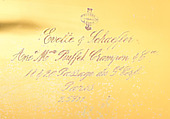Contrabass saxophone in E flat
Evette-Schaeffer French
The contrabass is an original member of the saxophone family as conceived by Adolphe Sax (1814-1894), the inventor of the saxophone. The first documented appearance of a contrabass, the lowest voice of the family, was at the 1849 Industrial Exhibition in Paris. Sax envisaged that the contrabass and bass saxophones would fill the need for a robust, expressive, low wind instrument in the orchestra and wind band. Remarkably, the contrabass displayed here was designed for playing on the move. The two rings on the back of this instrument are for attaching a carrying strap. This example was brought into America by the U.S. military for use in concert and marching bands. Its attention-grabbing appearance made it popular with vaudeville acts and dance bands. This instrument was used in the Meyer Davis Band in New York in the 1920s and then in the Charles Houston Novelty Jazz Orchestra of Philadelphia. Paul Cohen acquired the instrument in the early 1980s. His solo and chamber music performances with it have helped to rekindle an interest in the contrabass saxophone.
(Bradley Strauchen-Scherer)
Due to rights restrictions, this image cannot be enlarged, viewed at full screen, or downloaded.
This artwork is meant to be viewed from right to left. Scroll left to view more.





